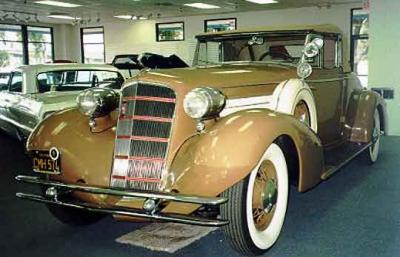
Click to supersize
1934 Cadillac Model 355
The 1934 Cadillacs were completely restyled and mounted
on an entirely new chassis, but used the same basic engines as in 1933.
Bodies
- Bodies on the Series 10 and 20 cars were built by Fisher.
- Bodies on the V-8 Fleetwood Series were shared with the twelves and sixteens.
- Styling emphasized streamlining including concealment of all chassis features
except the wheels
- Body construction was improved for better insulation against engine heat and
reduction of engine, road, and wind noise.
- Bumpers were a stylish but ineffective biplane design, mounted against
telescoping springs.
- The grill was Vee shaped and sloping, set into a painted shell.
- Although restricted use of chrome was a feature of the overall ornamentation,
a chrome plated radiator shell was available as an option.
- Horns and radiator filler cap were concealed under the hood.
- Teardrop Guide Multibeam headlights were mounted on streamlined supports
attached to the fenders.
- Parking lamps were mounted in the headlight supports.
- Airfoil shaped front fenders were brought low over the chassis.
- The hood sills were high, with the entire fender shape molded into the
radiator shell.
- A curious horizontal crease broke the nose contour of the fenders.
- Hoods extending nearly to the windshield carried shutter type louvers in the
side panel.
- Windshields were fixed and steeply sloping; 18 degrees flat on Fisher bodies,
25 degrees flat or 29-1/2 degrees Vee on Fleetwood bodies.
- Cowl vents opened toward the windshield; one vent on flat windshield bodies,
two vents projecting through openings in the hood on Vee windshield bodies.
- Bodies were two inches lower than on previous models.
- Added passenger space in the front compartment was achieved by moving the hand
brake lever to the left of the driver, under the instrument panel.
- On twelves and sixteens, the gearshift lever was moved forward to the clutch
housing.
- Rear fenders were airfoil shaped and carried rear lights which matched the
headlights.
- The gas tank filler on Fisher bodies was on the left side at the rear of the
body; on Fleetwood bodies in the left rear fender.
- All bodies featured a beaver tail rear deck which completely covered the
chassis.
- On Fleetwood bodies, the spare was concealed inside the rear deck, unless
optional fender mounts were specified.
Chassis:
- Significant changes in chassis design resulted in improved riding and handling
plus decreased driver fatigue.
- The new independent "knee action" front suspension with coil springs and
center point steering resulted in greatly reduced unsprung weight.
- Front shocks were now an integral part of the suspension; the shock arm being
the upper suspension arm.
- An inverted steering box, mounted on the outside of the frame, was used on
Fleetwood bodied cars.
- Hotchkiss drive replaced the torque tube drive.
- Rear brakes were operated by pull rods and cables.
- A new frame of X design added to chassis strength and allowed for the
reduction in overall vehicle height.
- A stabilizer bar to control body roll in turns was added at the rear of the
chassis.
- The brake and clutch pedal assembly was relocated from transmission to frame.
- Mufflers on Fleetwood bodied cars were relocated to the outside of the frame.
- In Fisher bodies, the battery was under the front seat, on the right side.
- In the Fleetwood bodies, the battery was under the right front fender and was
removed from underneath.
Engine
- Engine changes were few, but horsepower was increased.
- All engines used Lynite Aluminum pistons.
- Compression ratios were increased.
- Intake ducting to the carburetor air cleaner was extended to the radiator
casing, providing cold, dense air rather than the hot air in the engine
compartment.
- The combination of Aluminum pistons, cold intake air, and higher compression
with improved fuels resulted in increased horsepower and engine speeds.
- Detail changes in the V-8 engine included a change to the Detroit Lubricator
Carburetor, use of dual valve springs, discontinuation of the oil filter, and
solenoid starter control with starter button on instrument panel.
- One V-8 engine change to be appreciated by anyone removing a cylinder head was
the change from head studs to cap screws.
- The change was actually made so that the heads could be turned before lifting,
so as to clear the hood shelf.
- Another change, not necessarily appreciated was the elimination of provision
for hand cranking.